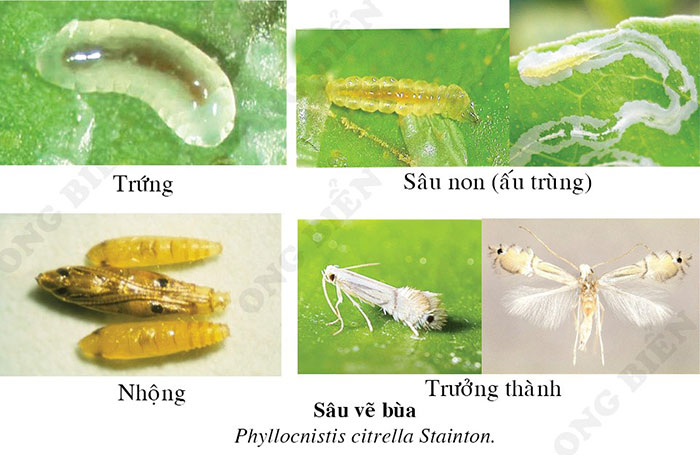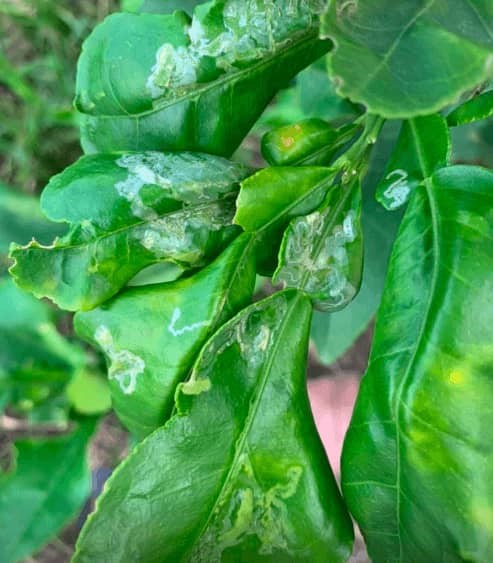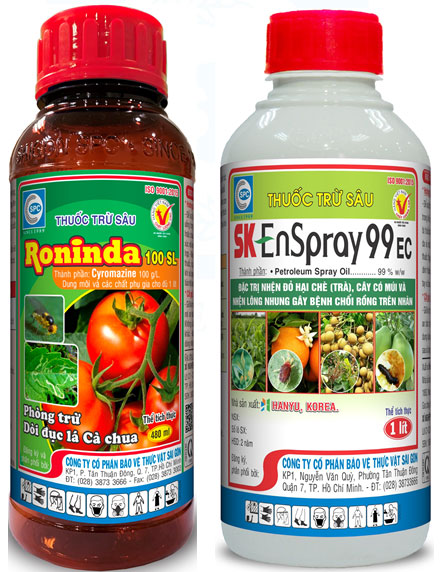|
Citrus Leafminer Prevention
25/07/2021
BSc Tran Thanh Tin Tangerine oranges, mango oranges, pink tangerines, etc. are citrus trees with a very large planting area, bringing high economic value to farmers. This group of plants has many types of pests and diseases that attack causing a lot of loss to farmers in terms of product quality and productivity, in which the leafminer is one of the harmful insects that are being concerned. Leafminer with scientific name: Phyllocnistis citrella Staintontain Family: Gracillariidae. Order: Lepidoptera. The leafminers cause damage almost all year round, especially when the tree has young buds, often causing much damage in July, August, and September. CHARACTERISTICS OF ECOLOGY - This is a small moth, about 2mm long, with a wingspan of 4-5mm. The body is pale yellow, slightly silvery. The forewings are willow leaf-shaped, the base of the wings is light gray, the rest of the wings is white, slightly silvery to yellow, with two black longitudinal veins from the base of the wing to the middle of the wing, about 1/3 towards the tip of the wing there is a Y-shaped oblique vein, wing tips with fairly long black edge of hairs. The hind wings are very narrow, often dark gray, with two very long, two outer edges of hairs are very long, light gray color
Eggs are flat oval, very small, about 0.2 - 0.3 mm. Newly laid eggs are transparent, about to hatch are opaque white, slightly yellowish. The incubation period for eggs is 2-7 days. - Newly hatched larva about 0.5mm long, light green body, almost transparent, brown head. The larva is large enough to be about 4mm long, greenish yellow in color, the body is no longer transparent. The larvas body is flat, has 13 segments, the two ends are small ,the thoracic and abdominal legs are degenerated, the last segment is long tubular. In the pre-pupal stage, The larvas body is no longer flat, but turns into opaque yellowish white tubular shape. Larva has 4 instars , develop in 5-20 days depending on external conditions. - The pupa is 2 - 3 mm long, the two ends are slender, light yellow at first, then turn yellowish brown with a very small spine on the head. The pupae develop in 7-15 days. HABITS OF LIFE AND HARMFUL WAYS - Moths are less attracted to light. During the day, moths hide in the foliage, at night they fly out and lay eggs, the strongest from 19 to 21 hours. From 12 to 15 hours after pairing, the female moth begins to lay eggs. -About 85% of eggs are laid within the first 2 days. Eggs are usually laid on the underside of leaves, averaging 2-3 eggs per leaf or young shoot. Most eggs are concentrated on either side of the main vein. Moths like to lay eggs in orange and tangerine orchards under 4 years old. - Newly hatched larvae bore right under the leaf epidermis and continue to feed into zigzag lines like the lines drawn on talismans, so the larva is called "leaf miner". The larva lives inside the bored line and feeds on the chlorophyll parenchyma cells. The epidermis, when newly separated from the parenchyma, is usually shiny, so it is easy to confuse it with the mucus streaks of snails left on the leaf surface when moving. - Infested leaves will curl, greatly limiting photosynthesis, and young shoots will stop growing. In addition to the above effect, the wounds caused by borers on the surface of leaves or shoots will create conditions for Xanthomonas campestris pv. Citri bacteria thrives, causing canker sores in orange trees, eventually destroying young shoots. The curled, shriveled orange, tangerine or lemon leaves created by leaf miners are also shelters for many other pests. PREVENTIVE MEASURES - In order to effectively prevent pests, it is necessary to prune branches, pruning at the same time to help produce young buds at the same time, which will control leaf miners well. - Clean the garden, collect and destroy, when the plants have young buds, it is the right time for the larvae to reproduce, need to spray immediately. - When young buds appear, they should be sprayed biological insecticides such as Comda Gold 5WG or Comda 250EC, in addition, they must regularly monitor the garden to protect young buds, detect timely, and limit the attack of the leaf miners.. - Gardens that are often under great pressure of leaf miners can use the Roninda 100SL insecticide, which is an insect growth regulator, has a fast contact, systemic and translocation effect, and penetrates quickly through plant tissues and leaves. affects the nervous system of the larval stage (larva), prevent the exchange of chitin, making the insect unable to complete its life cycle. -Can mix Roninda 100SL with mineral oil SK EnSpray 99EC and other pesticides and fungicides. - Spray time: + From the time the plant has young buds until. When the last leaf in the bud opens completely, stop spraying, spray 2-3 times 7-10 days apart. + When you see a lot of moths in the garden, spray it. |
To prevent, in addition to plowing and burying weed seeds, collecting weed stalks and stumps left after tilling the land to burn, not letting weeds produce seeds in production fields, etc., the use of chemical products is still a measure. optimal because of its ability to thoroughly kill weeds, reduce labor and take advantage of more time than manual weeding.
Miner has the scientific name Phyllocnistis citrella Staint., family Phyllocnistidae, order Lepidoptera. The miner occurs in many countries in the tropics and subtropics. The main host of the miner is the citrus family - Rutaceae. In addition, the miner also attacks mangosteen and some other plants.
Adult is a small planthopper, with a body 2-3 mm long, the whole body is ash gray, slightly greenish, the wings are opaque with many small brown spots.Eggs are oval, 0.3 mm long, have a pointed end and are attached directly to the leaf surface, leaf axils.
Green bugs specialize in the fruit of citrus groups (oranges, tangerines, lemons, grapefruits, kumquats...), some people call them orange bugs, or orange suckers. Their scientific name is Rhynchocoris poseidon or Rhynchocoris humeralis.
In Vietnam, yellow leaf curl disease is very common on papaya trees, especially the disease is often severe in areas of high and continuous planting, areas with hot and arid climates. The disease has significantly reduced the yield and quality of papaya. Gardens that are infected early when the plants are young may not yield. However, up to now, many gardeners still do not know the cause and how to fix it.
Spider mites are common pests on citrus trees, especially in hot and dry climates that are suitable for spiders to grow and cause severe damage.The group of harmful spiders is usually very small in size, unlike the natural enemy spiders.
This group includes species that are generally very small in size, causing damage by sucking plant sap (on leaves, fruits, branches, stems).
There are many species of mealybugs present on the group of Oranges,Tangerines,Grapefruits and Lemons (Citrus), which can be divided into 2 groups:
+ Group of sticky mealybugs with common varieties such as Lepidosaphes, Aonidiella, Coccus and Saissetia.
+ Group of flower mealybugs with common genera and species such as Pseudococcus, Planococcus and Icerya purchasi.
Dry branches and berries disease often appear to be common damage on coffee gardens during the rainy season. The disease causes death of branchs, dry fruit, severely affects the canopy structure and coffee yield if not paid attention to prevention.
Pink disease commonly causes diseases on rubber plantations in the rainy season, especially on garden from 4-8 years old. This year, rubber has to go through a period of severe drought, weakening the tree, so now in tnshe rainy season it is easy to get infected. Therefore, it is necessary to pay attention to good management to avoid affecting the garden.
In recent years, the area of citrus has been expanded because it is a fruit tree with high economic efficiency. However, in order to sell at a high price, not only in quality but consumers also require the external beauty of the fruit, so pest management on citrus is a matter of great concern to farmers. The hot season is a favorable condition for thrips to develop and cause damage, affecting the commercial value of fruit.
- Headquarters
- SAIGON PLANT PROTECTION JOINT STOCK COMPANY
- RQ 1, Nguyen Van Quy St., Tan Thuan Ward, HCM City
- Tax code: 0300632232
- Tel: (028) 38 733 295 - 38 732 077
- Fax: (028) 38 733 003 - 38 733 391
- Website: www.spchcmc.vn - Email: info@spchcmc.vn
- SAIGON PLANT PROTECTION COMPANY
- SAIGON PLANT PROTECTION JOINT STOCK ENTERPRISE
- Lot C1-C3 Hiep Phuoc Industrial Park, Hiep Phuoc Commune, HCM City
- Tel: (028) 3873 4089 - Fax: (028) 3873 4086
- Affiliated Unit
-
- Quick Links
- Home
- About us
- Career Opportunities














